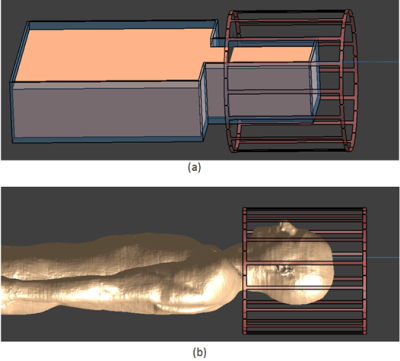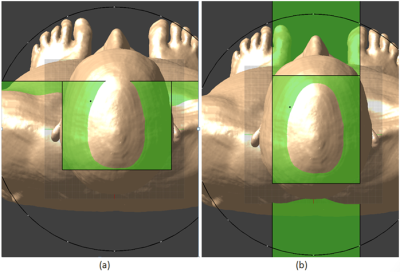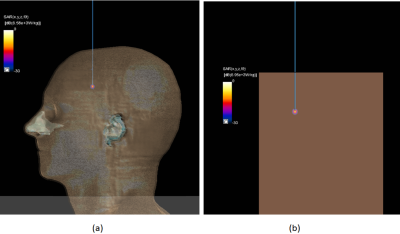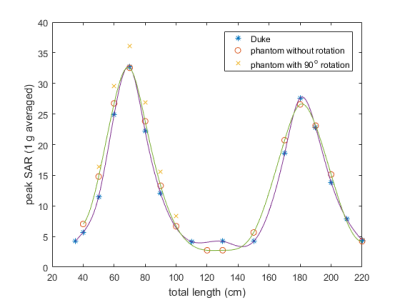1471
Resonant heating study of a partially immersed implant in ASTM phantom and Human Model1Physics, Case Western Reserve University, Cleveland, OH, United States, 2Imaging Institute, Cleveland Clinic, Cleveland, OH, United States
Synopsis
The RF heating of partially immersed implants in homogenous phantoms is reported to be highest for conductors at the resonant length. When addressing RF safety concerns, it is important to understand if these results apply to the heterogeneous structure within the human head. In this study, numerical simulations of RF heating of a partially immersed wire in an ASTM phantom are compared to an IT’IS virtual human model (Duke) for a head-only RF transmit coil in a 3 T MRI. We find that the resonant lengths are the same in both cases but the peak SAR changes slightly.
Introduction
The presence of implants in the human head during the MR scans introduces a risk of RF heating injury to the tissue adjacent to the implant. In situations with a partially immersed implant, phantom studies have reported the maximum heating occurs when the implant length matches the RF heating resonant length1-3. However, the resonant pattern may be different in homogenous (single tissue type) phantom which has different shape and tissue distribution than the heterogeneous (multiple tissue type) human head. So, in this work, we studied the SAR variation with the length of the partially immersed conducting wire having fixed value of the immersed length (penetration depth) for a phantom as well as a virtual human model, using finite difference time domain (FDTD) method.Methods
All simulations were performed using Sim4Life (v3.2, ZMT, Zurich, Switzerland) with a 16 rung, quadrature birdcage RF transmit coil tuned to the frequency of 127.6 MHz equivalent to 3 T MRI system. An insulated copper wire of diameter 0.7 mm and insulation thickness of 0.45 mm was used as the implant conductor. The wire had the conductivity of 58x106 S/m and the insulation had zero conductivity. For phantom study, a whole body torso shaped phantom (ASTM phantom) was used with the phantom conductivity of 0.47 S/m and dielectric constant of 79 (Figure 1(a)). The wire, with 2 mm of its tip exposed, was introduced into the crown of phantom, parallel to the coil axis, with 5 cm of it immersed into the phantom. The outside length of the wire was then varied with total length lying in the range of 40 cm to 220 cm and the peak SAR (IEEE/IEC) was recorded for each length. Similarly, for human model study, the same process was repeated with identical coil and wire and having same value of immersed length (5 cm) into the crown of an adult human model ‘Duke’ (IT’IS Foundation, Zurich, Switzerland) as shown in figure (Figure 1(b)). Later on, the phantom was rotated at 90° about the coil axis, so that it better matches the Duke head orientation (Figure 2(b) compared to its original one (Figure 2(a)), without making any change on the RF coil and the wire conductor. Then for this setup also, the wire length was changed to study the peak SAR variation.Results
The local SAR distributions within the head of the Duke model and the phantom are shown in the figures 3 (a) and (b) respectively. The peak spatial SAR (IEEE/IEC 1 g averaged) variation with the length of the wire conductor for Duke Model, phantom original orientation and the phantom with 90° rotation are shown in the plot (Figure 4).Discussions
Figures 3 (a) and (b) show that, for both Duke and the phantom, the RF heating is localized at the tip of the wire. The plots (Figure 4) show the resonant lengths for the human model and the phantom are exactly same (first resonance at 70 ± 10 cm) for both orientations of the phantom. The peak SAR showed some change with the change in the phantom orientation, which is as expected since the electric field at the position of the immersed part of the wire may change relative to the orientation of the phantom.Conclusions
The difference between the phantom and the human head in terms of the shape (geometry) and the tissue properties (homogenous phantom vs heterogeneous human model) does not change the resonant lengths of a partially immersed conducting implant with fixed value of immersed length, but may change the peak spatial SAR at the resonant lengths.Acknowledgements
This work was supported in part by a fellowship from Dr Imad Najm and the Cleveland Clinic Epilepsy Center, Cleveland, OH, USA.References
1. Young CJ, Karmarkar P, and McVeigh ET. Minimizing RF Heating of Conducting Wires in MRI. Magn Reson Med 2007; 58:1028-1034.
2. Armenean C, Perrin E, Armenean M, Beuf M, Pilleul F, Saint-Jalmes H. RF-induced Temperature Elevation Along Metallic Wires in Clinical Magnetic Resonance Imaging: Influence of Diameter and Length. Magn Reson Med 2004; 52:1200-1206.
3. Bhattacharyya P, Baig T, Bhusal B, Lowe M, Martens M, Jfones S. Dependence of RF induced heating pattern of a single wire on its mode of entry in a dielectric medium. Proc. Intl. Soc. Mag. Reson. Med. 25(2017), 2650.
Figures



